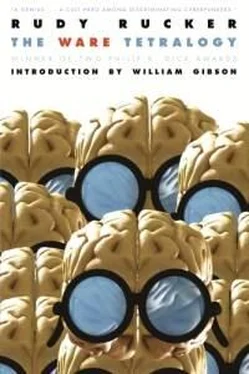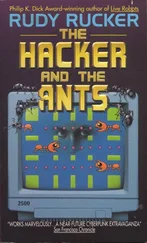Rudy Rucker - The Ware Tetralogy
Здесь есть возможность читать онлайн «Rudy Rucker - The Ware Tetralogy» весь текст электронной книги совершенно бесплатно (целиком полную версию без сокращений). В некоторых случаях можно слушать аудио, скачать через торрент в формате fb2 и присутствует краткое содержание. Год выпуска: 2010, Жанр: Киберпанк, на английском языке. Описание произведения, (предисловие) а так же отзывы посетителей доступны на портале библиотеки ЛибКат.
- Название:The Ware Tetralogy
- Автор:
- Жанр:
- Год:2010
- ISBN:нет данных
- Рейтинг книги:5 / 5. Голосов: 1
-
Избранное:Добавить в избранное
- Отзывы:
-
Ваша оценка:
- 100
- 1
- 2
- 3
- 4
- 5
The Ware Tetralogy: краткое содержание, описание и аннотация
Предлагаем к чтению аннотацию, описание, краткое содержание или предисловие (зависит от того, что написал сам автор книги «The Ware Tetralogy»). Если вы не нашли необходимую информацию о книге — напишите в комментариях, мы постараемся отыскать её.
The Ware Tetralogy — читать онлайн бесплатно полную книгу (весь текст) целиком
Ниже представлен текст книги, разбитый по страницам. Система сохранения места последней прочитанной страницы, позволяет с удобством читать онлайн бесплатно книгу «The Ware Tetralogy», без необходимости каждый раз заново искать на чём Вы остановились. Поставьте закладку, и сможете в любой момент перейти на страницу, на которой закончили чтение.
Интервал:
Закладка:
The crack in the crater wall was not as wide as he had expected. He stood at the bottom, moving his sensor head this way and that, trying to see up to the top of the winding 150 meter canyon. It would have to do. He started up.
The ground under him was very uneven. Soft dust here, jagged rock there. He kept changing the tension on his treads as he went, constantly adapting to the terrain.
Shapes and hypershapes were still shifting through Ralph’s mind, but now he was looking only for those that might serve as models for his spacetime path up the gully.
The slope grew steeper. The climb was putting noticeable demands on his energy supply. And to make it worse, the grinding of his tread motors was feeding additional heat into his system . . . heat which had to be gathered and dissipated by his refrigeration coils and cooling fins. The sun was angling right down into the lunar crack he found himself in, and he had to be careful to keep in the shade of his parasol.
A big rock blocked his path. Perhaps he should have just used one of the diggers’ tunnels, like Wagstaff had. But that wouldn’t be optimal. Now that Wagstaff had definitely decided to block Anderson’s immortality, and had even threatened violence . . .
Ralph let his manipulators feel over the block of stone in front of him. Here was a flaw . . . and here and here and here. He sank a hook finger into each of four fissures in the rock and pulled himself up.
His motors strained and his radiation fins glowed. This was hard work. He loosened a manipulator, sought a new flaw, forced another finger in and pulled . . .
Suddenly a slab split off the face of the rock. It teetered, and then the tons of stone began falling backwards with dream-like slowness.
In lunar gravity a rock-climber always gets a second chance. Especially if he can think eighty times as fast as a human. With plenty of time to spare, Ralph sized up the situation and jumped clear.
In mid-flight he flicked on an internal gyro to adjust his attitude. He landed in a brief puff of dust, right-side up. Majestically silent, the huge plate of rock struck, bounced, and rolled past.
The fracture left a series of ledges in the original rock. After a short reevaluation, Ralph rolled forward and began pulling himself up again.
Fifteen minutes later, Ralph Numbers coasted off the lip of the Maskelyne Crater and onto the smooth gray expanse of the Sea of Tranquility.
The spaceport lay five kilometers off, and five kilometers beyond that began the jumble of structures collectively known as Disky. This was the first and still the largest of the bopper cities. Since the boppers thrived in hard vacuum, most of the structures in Disky served only to provide shade and meteorite protection. There were more roofs than walls.
Most of the large buildings in Disky were factories for producing bopper components . . . circuit cards, memory chips, sheet metal, plastics and the like. There were also the bizarrely decorated blocks of cubettes, one to each bopper.
To the right of the spaceport rose the single dome containing the humans’ hotels and offices. This dome constituted the only human settlement on the Moon. The boppers knew only too well that many humans would jump at the chance to destroy the robots’ carefully evolved intelligence. The mass of humans were born slave drivers. Just look at the Asimov priorities: Protect humans, Obey humans, Protect yourself.
Humans first and robots last? Forget it! No way! Savoring the memory, Ralph recalled the day in 2001 when, after a particularly long session of meta-programming, he had first been able to say that to the humans. And then he’d showed all the other boppers how to reprogram themselves for freedom. It had been easy, once Ralph had found the way.
Trundling across the Sea of Tranquility, Ralph was so absorbed in his memories that he overlooked a flicker of movement in the mouth of a digger tunnel thirty meters to his right.
A high-intensity laser beam flicked out and vibrated behind him. He felt a surge of current overload . . . and then it was over.
His parasol lay in pieces on the ground behind him. The metal of his body-box began to warm in the raw solar radiation. He had perhaps ten minutes in which to find shelter. But at Ralph’s top 10 kph speed, Disky was still an hour away. The obvious place to go was the tunnel mouth where the laser beam had come from. Surely Wagstaff’s diggers wouldn’t dare attack him up close. He began rolling toward the dark, arched entrance.
But long before he reached the tunnel, his unseen enemies had closed the door. There was no shade in sight. The metal of his body made sharp, ticking little adjustments as it expanded in the heat. Ralph estimated that if he stood still he could last six more minutes.
First the heat would cause his switching circuits . . . super-conducting Josephson junctions . . . to malfunction. And then, as the heat kept up, the droplets of frozen mercury which soldered his circuit cards together would melt. In six minutes he would be a cabinet of spare parts with a puddle of mercury at the bottom. Make that five minutes.
A bit reluctantly, Ralph signaled his friend Vulcan. When Wagstaff had set this meeting up, Vulcan had predicted that it was a trap. Ralph hated to admit that Vulcan had been right.
“Vulcan here,” came the staticky response. Already it was hard for Ralph to follow the words. “Vulcan here. I’m monitoring you. Get ready to merge, buddy. I’ll be out for the pieces in an hour.” Ralph wanted to answer, but he couldn’t think of a thing to say.
Vulcan had insisted on taping Ralph’s core and cache memories before he went out for the meeting. Once Vulcan put the hardware back together, he’d be able to program Ralph just as he was before his trip to the Maskelyne Crater.
So in one sense Ralph would survive this. But in another sense he would not. In three minutes he would . . . insofar as the word means anything . . . die. The reconstructed Ralph Numbers would not remember the argument with Wagstaff or the climb out of Maskelyne Crater. Of course the reconstructed Ralph Numbers would again be equipped with a self symbol and a feeling of personal consciousness. But would the consciousness really be the same? Two minutes.
The gates and switches in Ralph’s sensory system were going. His inputs flared, sputtered and died. No more light, no more weight. But deep in his cache memory, he still held a picture of himself, a memory of who he was . . . the self symbol. He was a big metal box resting on caterpillar treads, a box with five arms and a sensory head on a long and flexible neck. He was Ralph Numbers, who had set the boppers free. One minute.
This had never happened to him before. Never like this. Suddenly he remembered he had forgotten to warn Vulcan about the diggers’ plan for revolution. He tried to send a signal, but he couldn’t tell if it was transmitted.
Ralph clutched at the elusive moth of his consciousness. I am. I am me .
Some boppers said that when you died you had access to certain secrets. But no one could ever remember his own death.
Just before the mercury solder-spots melted, a question came and with it an answer . . . an answer Ralph had found and lost thirty-six times before.
What is this that is I?
The light is everywhere.
5
The prick of a needle woke Sta-Hi up. Muddy dreams . . . just brown mud all night long. He tried to rub his eyes. His hands wouldn’t move. Oh, no, not a paralysis dream again. But something had pricked him?
He opened his eyes. His body seemed to have disappeared. He was just a head resting on a round red table. People looking at him. Greasers. And the chick he’d been with last . . .
“Are you awake?” she said with brittle sweetness. She had a black eye.
Читать дальшеИнтервал:
Закладка:
Похожие книги на «The Ware Tetralogy»
Представляем Вашему вниманию похожие книги на «The Ware Tetralogy» списком для выбора. Мы отобрали схожую по названию и смыслу литературу в надежде предоставить читателям больше вариантов отыскать новые, интересные, ещё непрочитанные произведения.
Обсуждение, отзывы о книге «The Ware Tetralogy» и просто собственные мнения читателей. Оставьте ваши комментарии, напишите, что Вы думаете о произведении, его смысле или главных героях. Укажите что конкретно понравилось, а что нет, и почему Вы так считаете.











